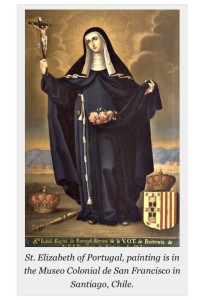
St. Elizabeth of Portugal (1271-1336)
Image: Pinterest
(Franciscan Media) Born in Spain Aragon, Elizabeth was named after her Great Aunt ‘Elizabeth of Hungary’ but is known in the Portuguese history by the Spanish form of that name ‘Isabel’ according to EWTN — the daughter of Pedro III, the King of Aragon and Constantia, Grandchild of Emperor Frederick II, Elizabeth was educated in a devout religious environment of strict regularity and self-disciplined throughout her childhood.
Given these healthy influences upon her character development, Elizabeth acquired a taste for spirituality and by the age of 12, was emotionally prepared to meet the challenges of marriage to King Diniz of Portugal.
Now Queen Elizabeth of Portugal, she was able to establish for herself a pattern of life conducive to continued growth in God’s love, not merely through exercises of religious devotion and daily Mass but also through her commitment to charity, by which she was able to befriend and help transients, strangers, the sick, poor–all those whose needs came to her attention, all the while remaining devoted to her husband, whose infidelity towards her was a scandal within the kingdom.
King Diniz was the object of many of Elizabeth’s peace endeavors–she long sought peace for her husband with God and was finally rewarded when he gave up his life of sin.
Elizabeth likewise sought and effected peace between her husband King Diniz and their rebellious son Alfonso, who had believed that he was passed over to favor King Diniz’s illegitimate children. — Elizabeth acted as a peacemaker in the struggle between King Ferdinand of Aragon and his cousin James who claimed the thrown.
In 1325 King Diniz passed away and he was succeeded by his son Alfonso IV — Elizabeth subsequently retired to a Convent of ‘Poor Clares’ which she founded at Coimbra, subsequently taking the Franciscan Tertiary habit, wishing to devote the rest of her life to the poor and the sick in obscurity but in 1336, she was called back once more to act as a peacemaker when Alfonso IV marched his troops against the King of Castile, to whom he had married his daughter Maria off to after she she was neglected and poorly treated.
Elizabeth’s efforts were successful in stopping the fighting armies and caused terms of peace to be arranged but her tireless efforts took its toll and just as soon as her mission was fulfilled, Elizabeth passed away on this date in 1336 full of heavenly joy and exhorting her son to the love of holiness, reconciliation and peace in her family.
Queen Elizabeth of Portugal was buried at Coimbra, many miracles were reported following her death at her tomb — In 1625 she was Canonized by Pope Urban VIII
Tweet